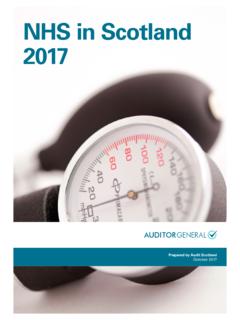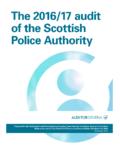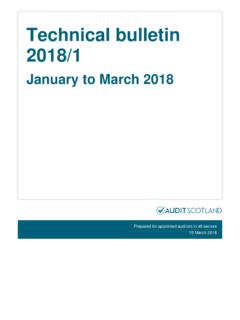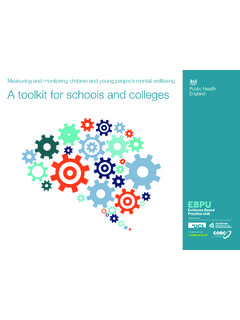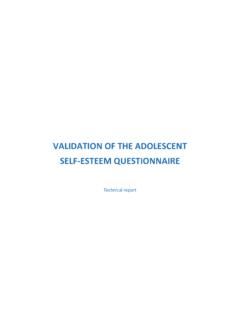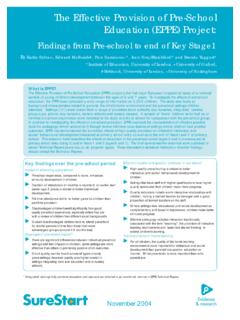Transcription of Improving outcomes for young people ... - Audit Scotland
1 Improving outcomes for young people through school educationPrepared by Audit ScotlandMarch 20212 ContentsKey messages 3 outcomes 11 Inequalities 25 Working together to improve outcomes 34 Spending on education 42 Endnotes 49 Appendix 1. Methodology 52 Appendix 2. Advisory group 55 Audit teamThe core Audit team consisted of: Tricia Meldrum, Beverley Oakman, Zoe McGuire and Martin Allan, with support from colleagues and under the direction of Antony downloadWeb linkExhibit dataWhen viewing this report online, you can access background data by clicking on the graph icon.
2 The data file will open in a new messages1 School education is not just about exam results. It also aims to improve children s and young people s health and wellbeing and support wider outcomes such as vocational qualifications. The Covid-19 pandemic has affected children and young people in many ways, including their learning, wellbeing and economic circumstances. Pupils living in the most challenging circumstances have been most affected by school closures. 2 Those involved in planning, delivering and supporting school education were working well together prior to the pandemic.
3 This strong foundation helped them to collaborate to deliver a rapid response to Covid-19 in exceptionally challenging circumstances. The pandemic has reinforced the importance of school education and other sectors working together to tackle issues which affect young people s life chances and outcomes , such as child poverty and health and wellbeing. 3 Both national education policy and the curriculum reflect the importance for pupils of different pathways and opportunities, and outcomes beyond exam results. There has been an increase in the types of opportunities, awards and qualifications available to children and young people and an increase in the number awarded.
4 However, better data is needed to understand if other outcomes , like wellbeing and confidence, are There is wide variation in education performance across councils, with evidence of worsening performance on some indicators in some councils. At the national level, exam performance and other attainment measures have improved. But the rate of improvement up until 2018 19 has been inconsistent across different measures. Key messages4 measuring progress has been hampered by the cancellation of exams and other data gaps caused by Covid-19. This could create risks around The poverty-related attainment gap remains wide and inequalities have been exacerbated by Covid-19.
5 Progress on closing the gap has been limited and falls short of the Scottish Government s aims. Improvement needs to happen more quickly and there needs to be greater consistency across the country. The government and councils recognise that addressing inequalities must be at the heart of the response to Covid-19, longer-term recovery and Improving education. 6 Council spending on primary and secondary school education across Scotland increased by per cent in real terms between 2013/14 and 2018/19, from billion to billion. Most of the real-terms increase in spend can be attributed to the Attainment Scotland Fund, which the Scottish Government set up in 2015/16 to close the poverty-related attainment gap.
6 When this is excluded, real-terms spending increased by per cent during the period, to just over billion. The Scottish Government had put over 200 million of extra money into Covid-19 mitigation measures and education recovery by early January messages5 Recommendations The Scottish Government, councils and Education Scotland should work together to take forward the recommendations, where appropriate, within the context of a collaborative system and with lead responsibility as set out Scottish Government should: continue to lead the development of priorities for education recovery and improvement, building on the actions set out in the National Improvement Framework (NIF)
7 For 2021, the Equity Audit and the forthcoming OECD review, being clear about anticipated outcomes and milestones work with stakeholders to develop and publish consistent and robust national data that reflects the ambitions of the national curriculum, national policy priorities such as health and wellbeing and confidence, and key priorities for Covid-19 recovery and improvement update the NIF to reflect data on these agreed outcomes and consider how to ensure that there is greater prominence on these broader outcome measures in public reporting and messaging, for example by inclusion in the NIF key indicators work with stakeholders to agree an approach to dealing with the challenges created by data disruption in 2020 and 2021 which will affect monitoring of progress in achieving policy ambitions relating to outcomes and the attainment gap ensure that future methods for targeting support to address inequalities reflect broader demographic issues, which are not well reflected in the Scottish Index of Multiple Deprivation (SIMD)
8 , and updated data on the economic impact of Covid-19 on Scotland should work with schools, councils and RICs to: understand the factors that cause variation in performance across schools and councils achieve greater consistency in applying the NIF drivers through a targeted response that reflects local priorities for improvement, with a focus on reducing inequalities ensure the successful innovation and learning from the Covid-19 response, such as the opportunities from using digital learning, informs future planning for improved outcomes for children and young should.
9 Work with schools, Regional Improvement Collaboratives, other policy teams and partners, for example in the third sector, to reduce variability in outcomes by more consistent application of the drivers of improvement set out in the NIF, by: using data to understand trends in outcome measures over time and across different demographic groupsKey messages6 using evidence-based quality-improvement approaches sharing learning and applying good practice across schools and councils helping schools to build up their data analytical, evaluation and quality- improvement skills so they can make evidence-based decisions monitor the short- and longer-term impacts of Covid-19 (including the impact of remote learning)
10 On local children s and young people s learning and wellbeing and take action when required to mitigate the effects and improve outcomes more effectively and consistently involve young people and parents in planning to improve outcomes and to inform the local response to Covid-19 ensure third-sector organisations working with or representing children and young people are effectively involved in local planning to improve longer-term outcomes , and to deliver the local education response to Covid-19. The Scottish Government, Education Scotland and councils should.

